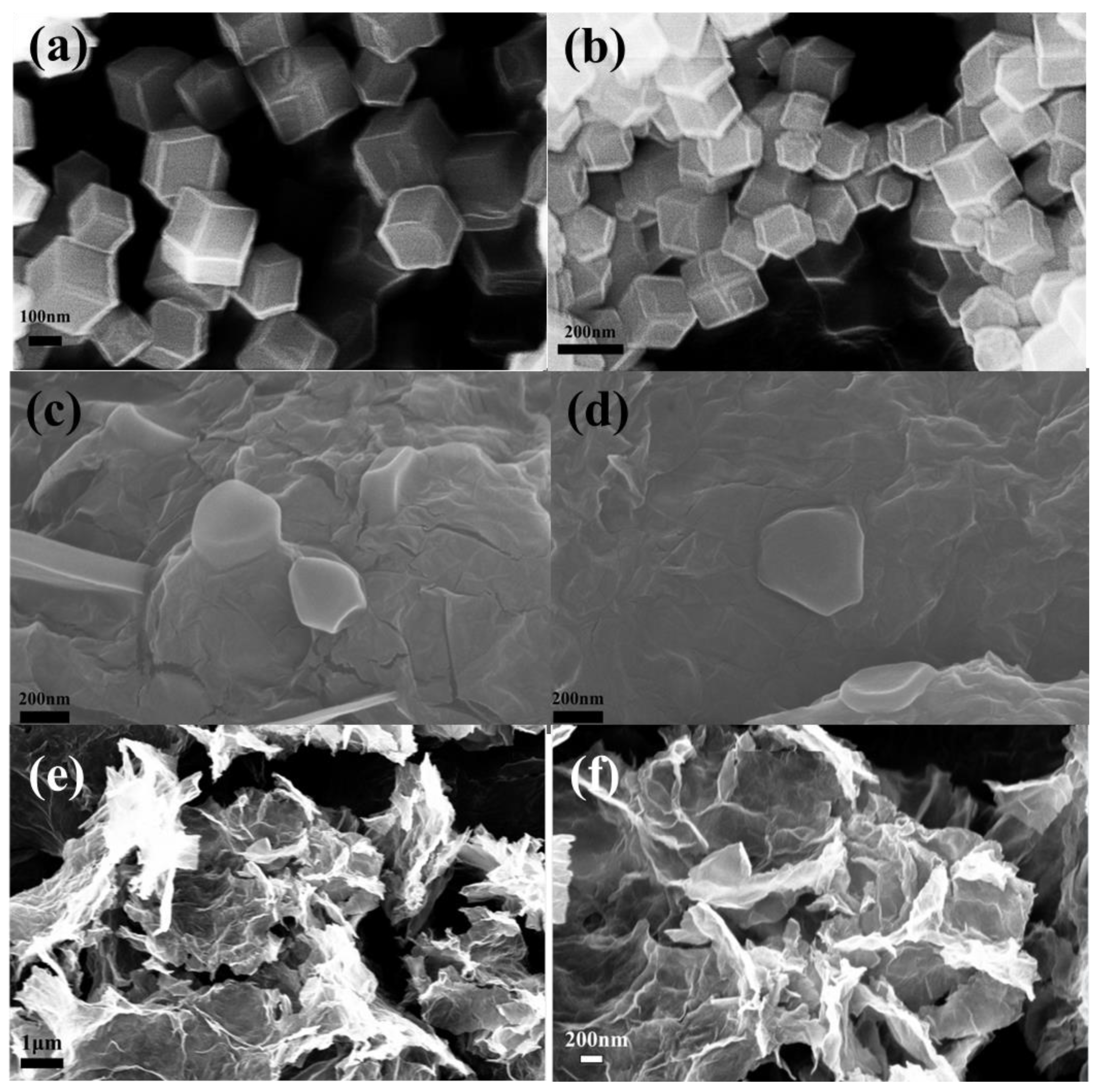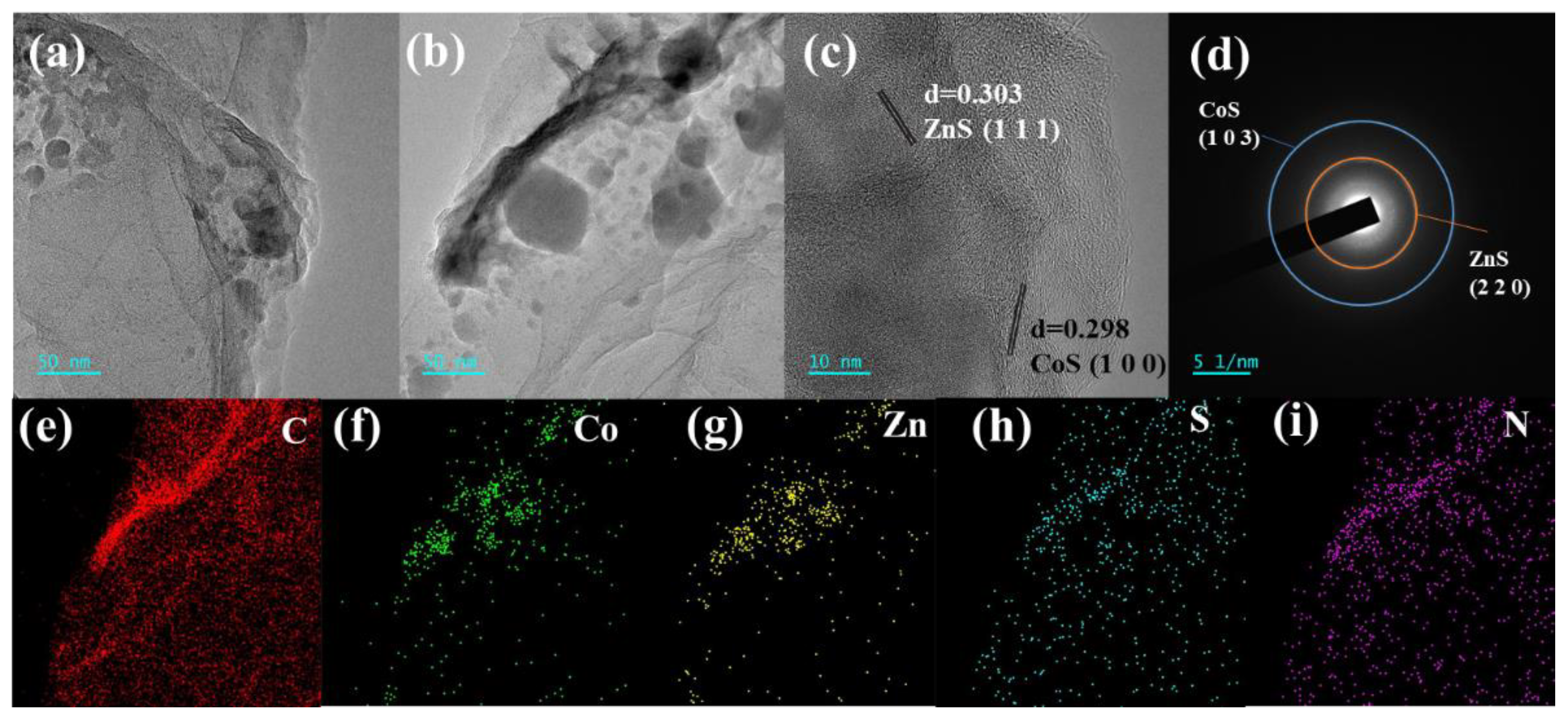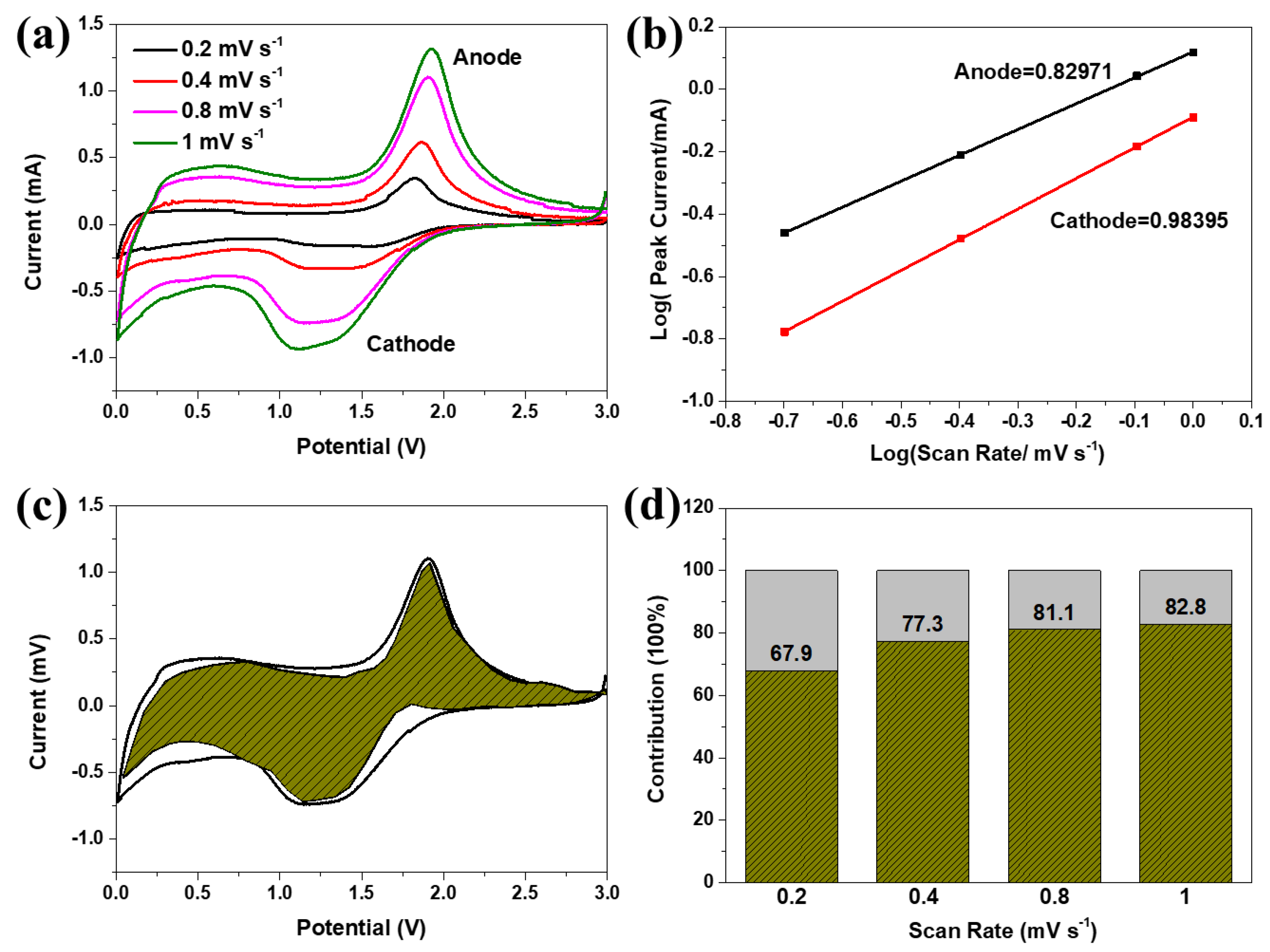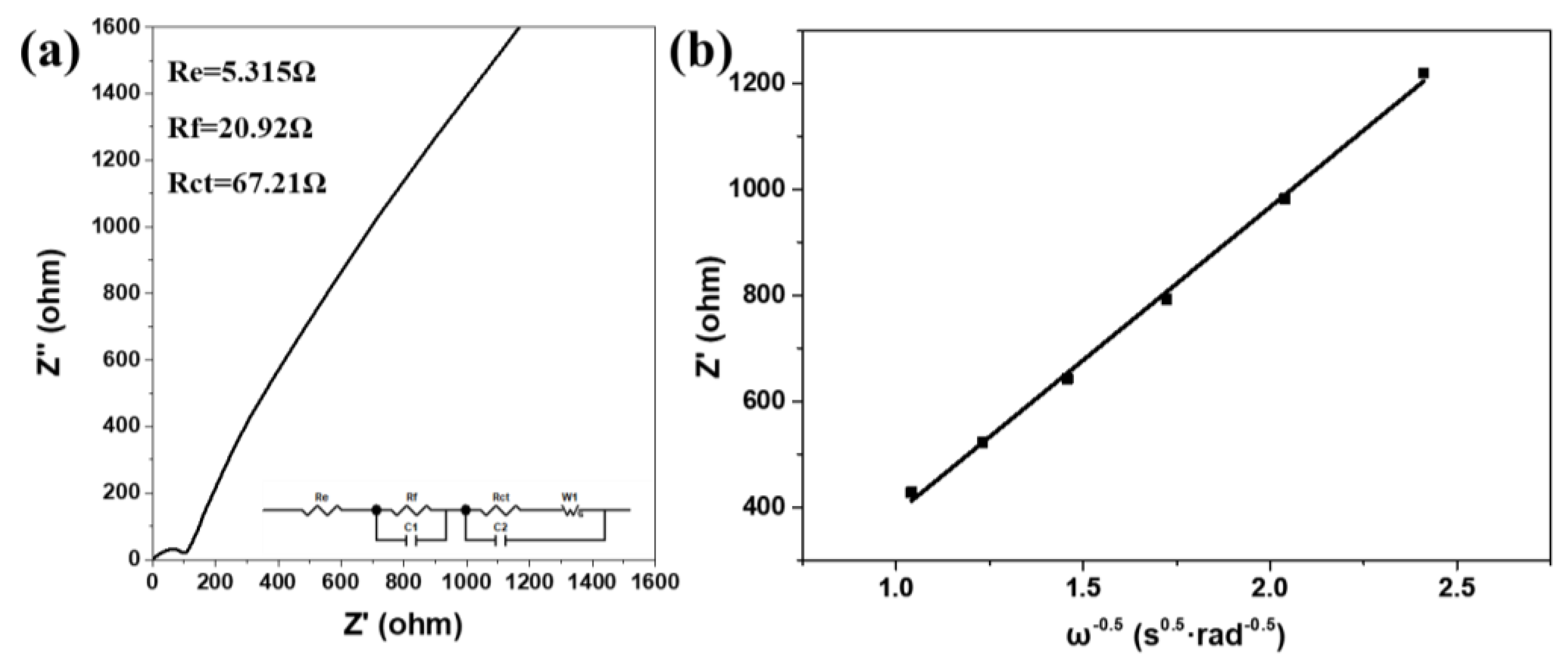ZnS/CoS@C Derived from ZIF-8/67 Rhombohedral Dodecahedron Dispersed on Graphene as High-Performance Anode for Sodium-Ion Batteries
Abstract
:1. Introduction
2. Results and Discussion
log(i) = blog(v) + log(a)
3. Materials and Methods
3.1. Synthesis of ZIF-8/67 Dodecahedron
3.2. Synthesis of ZIF-8/67/GO
3.3. Synthesis of ZnS/CoS@C/rGO
3.4. Material Characterization
3.5. Electrochemical Measurements
4. Conclusions
Author Contributions
Funding
Institutional Review Board Statement
Informed Consent Statement
Data Availability Statement
Conflicts of Interest
Sample Availability
References
- Yuan, Y.; Chen, Z.; Yu, H.; Zhang, X.; Liu, T.; Xia, M.; Zheng, R.; Shui, M.; Shu, J. Heteroatom-doped carbon-based materials for lithium and sodium ion batteries. Energy Storage Mater. 2020, 32, 65–90. [Google Scholar] [CrossRef]
- Lei, C.; Aldous, I.; Hartley, J.M.; Thompson, D.L.; Scott, S.; Hanson, R.; Anderson, P.A.; Kendrick, E.; Sommerville, R.; Ryder, K.S.; et al. Lithium ion battery recycling using high-intensity ultrasonication. Green Chem. 2021, 23, 4710–4715. [Google Scholar] [CrossRef]
- Jin, Y.; Zhu, B.; Lu, Z.; Liu, N.; Zhu, J. Challenges and Recent Progress in the Development of Si Anodes for Lithium-Ion Battery. Adv. Energy Mater. 2017, 7, 1700715. [Google Scholar] [CrossRef]
- Yang, X.; Rogach, A.L. Anodes and Sodium-Free Cathodes in Sodium Ion Batteries. Adv. Energy Mater. 2020, 10, 2000288. [Google Scholar] [CrossRef]
- Pan, E.; Jin, Y.; Zhao, C.; Jia, M.; Chang, Q.; Zhang, R.; Jia, M. Mesoporous Sn4P3-graphene aerogel composite as a high-performance anode in sodium ion batteries. Appl. Surf. Sci. 2019, 475, 12–19. [Google Scholar] [CrossRef]
- Fang, L.; Bahlawane, N.; Sun, W.; Pan, H.; Bin Xu, B.; Yan, M.; Jiang, Y. Conversion-Alloying Anode Materials for Sodium Ion Batteries. Small 2021, 17, 2101137. [Google Scholar] [CrossRef]
- Huang, Y.; Xiong, D.; Li, X.; Sari, H.M.K.; Peng, J.; Li, Y.; Li, Y.; Li, D.; Sun, Q.; Sun, X. Recent Advances of Bimetallic Sulfide Anodes for Sodium Ion Batteries. Front. Chem. 2020, 8, 353. [Google Scholar] [CrossRef]
- Wu, L.; Gao, J.; Qin, Z.; Sun, Y.; Tian, R.; Zhang, Q.; Gao, Y. Deactivated-desulfurizer-derived hollow copper sulfide as anode materials for advanced sodium ion batteries. J. Power Sources 2020, 479, 228518. [Google Scholar] [CrossRef]
- Zhang, J.; Song, K.; Mi, L.; Liu, C.; Feng, X.; Zhang, J.; Chen, W.; Shen, C. Bimetal Synergistic Effect Induced High Reversibility of Conversion-Type Ni@NiCo2S4 as a Free-Standing Anode for Sodium Ion Batteries. J. Phys. Chem. Lett. 2020, 11, 1435–1442. [Google Scholar] [CrossRef]
- Wang, L.; Yuan, J.; Zhao, Q.; Wang, Z.; Zhu, Y.; Ma, X.; Cao, C. Supported SnS2 nanosheet array as binder-free anode for sodium ion batteries. Electrochim. Acta 2019, 308, 174–184. [Google Scholar] [CrossRef]
- Hu, Y.; Zhang, L.; Bai, J.; Liu, F.; Wang, Z.; Wu, W.; Bradley, R.; Li, L.; Ruan, H.; Guo, S. Boosting High-Rate Sodium Storage of CuS via a Hollow Spherical Nanostructure and Surface Pseudocapacitive Behavior. ACS Appl. Energy Mater. 2021, 4, 8901–8909. [Google Scholar] [CrossRef]
- Zhang, Y.; Wang, P.; Yin, Y.; Liu, N.; Song, N.; Fan, L.; Zhang, N.; Sun, K. Carbon coated amorphous bimetallic sulfide hollow nanocubes towards advanced sodium ion battery anode. Carbon 2019, 150, 378–387. [Google Scholar] [CrossRef]
- Peng, S.; Han, X.; Li, L.; Zhu, Z.; Cheng, F.; Srinivansan, M.; Adams, S.; Ramakrishna, S. Unique Cobalt Sulfide/Reduced Graphene Oxide Composite as an Anode for Sodium-Ion Batteries with Superior Rate Capability and Long Cycling Stability. Small 2016, 12, 1359–1368. [Google Scholar] [CrossRef]
- Li, Y.; He, W.; Liu, X.; Li, Y.; Wang, Z.; Ming, X.; Liu, L.; Tan, C.; Yan, X. Interlayer expanded SnS/N-doped carbon/SnS ultra-thin composite driven from layered tin chalcogenides as advanced anode for lithium and sodium ion battery. J. Alloys Compd. 2023, 968, 171809. [Google Scholar] [CrossRef]
- Yin, H.; Jia, L.; Li, H.Y.; Liu, A.; Li, G.; Zhu, Y.; Huang, J.; Cao, M.; Hou, Z. Point-cavity-like carbon layer coated SnS nanotubes with improved energy storage capacity for lithium/sodium ion batteries. J. Energy Storage 2023, 65, 107354. [Google Scholar] [CrossRef]
- Wu, Z.-G.; Li, J.-T.; Zhong, Y.-J.; Liu, J.; Wang, K.; Guo, X.-D.; Huang, L.; Zhong, B.-H.; Sun, S.-G. Synthesis of FeS@C-N hierarchical porous microspheres for the applications in lithium/sodium ion batteries. J. Alloys Compd. 2016, 688, 790–797. [Google Scholar] [CrossRef]
- Zhao, Y.; Pang, Q.; Meng, Y.; Gao, Y.; Wang, C.; Liu, B.; Wei, Y.; Du, F.; Chen, G. Self-Assembled CoS Nanoflowers Wrapped in Reduced Graphene Oxides as the High-Performance Anode Materials for Sodium-Ion Batteries. Chem. A Eur. J. 2017, 23, 13150–13157. [Google Scholar] [CrossRef]
- Fan, A.; Hou, T.; Sun, X.; Xie, D.; Li, X.; Zhang, N.; Guo, J.; Jin, S.; Zhou, Y.; Cai, S.; et al. One-Pot Hydrothermal Synthesis of ZnS Nanospheres Anchored on 3D Conductive MWCNTs Networks as High-Rate and Cold-Resistant Anode Materials for Sodium-Ion Batteries. ChemElectroChem 2020, 7, 1904–1913. [Google Scholar] [CrossRef]
- Zheng, H.; Chen, X.; Li, L.; Feng, C.; Wang, S. Synthesis of NiS2/reduced graphene oxide nanocomposites as anodes materials for high-performance Sodium and Potassium ion batteries. Mater. Res. Bull. 2021, 142, 111430. [Google Scholar] [CrossRef]
- Dutta, D.P.; Pathak, D.D.; Abraham, S.; Ravuri, B.R. An insight into the sodium-ion and lithium-ion storage properties of CuS/graphitic carbon nitride nanocomposite. RSC Adv. 2022, 12, 12383–12395. [Google Scholar] [CrossRef]
- Zhong, M.; Kong, L.; Li, N.; Liu, Y.-Y.; Zhu, J.; Bu, X.-H. Synthesis of MOF-derived nanostructures and their applications as anodes in lithium and sodium ion batteries. Coord. Chem. Rev. 2019, 388, 172–201. [Google Scholar] [CrossRef]
- Xu, Z.; Huang, Y.; Chen, C.; Ding, L.; Zhu, Y.; Zhang, Z.; Guang, Z. MOF-derived hollow Co(Ni)Se2/N-doped carbon composite material for preparation of sodium ion battery anode. Ceram. Int. 2020, 46, 4532–4542. [Google Scholar] [CrossRef]
- Huang, Y.; Wang, M.; Huang, M.; Xiong, Y.; Yang, X.; Miao, Z.; Yang, Z.; Yu, J. Co0.85Se@carbon nanotubes surface-seeding grown on carbon microplates as superior anode material for sodium ion batteries. Electrochim. Acta 2022, 414, 140167. [Google Scholar] [CrossRef]
- Liu, Y.; Wei, G.; Pan, L.; Xiong, M.; Yan, H.; Li, Y.; Lu, C.; Qiao, Y. Rhombic Dodecahedron ZIF-8 Precursor: Designing Porous N-Doped Carbon for Sodium-Ion Batteries. ChemElectroChem 2017, 4, 3244–3249. [Google Scholar] [CrossRef]
- Li, W.; Hu, S.; Luo, X.; Li, Z.; Sun, X.; Li, M.; Liu, F.; Yu, Y. Confined Amorphous Red Phosphorus in MOF-Derived N-Doped Microporous Carbon as a Superior Anode for Sodium-Ion Battery. Adv. Mater. 2017, 29, 1605820. [Google Scholar] [CrossRef]
- Wang, X.; Chen, Y.; Fang, Y.; Zhang, J.; Gao, S.; Lou, X. Synthesis of Cobalt Sulfide Multi-shelled Nanoboxes with Precisely Controlled Two to Five Shells for Sodium-Ion Batteries. Angew. Chem. Int. Ed. 2019, 58, 2675–2679. [Google Scholar] [CrossRef]
- Li, Y.; Qian, J.; Zhang, M.; Wang, S.; Wang, Z.; Li, M.; Bai, Y.; An, Q.; Xu, H.; Wu, F.; et al. Co-Construction of Sulfur Vacancies and Heterojunctions in Tungsten Disulfide to Induce Fast Electronic/Ionic Diffusion Kinetics for Sodium-Ion Batteries. Adv. Mater. 2020, 32, 2005802. [Google Scholar] [CrossRef]
- Jia, M.; Jin, Y.; Zhao, C.; Zhao, P.; Jia, M. High electrochemical sodium storage performance of ZnSe/CoSe@N-doped porous carbon synthesized by the in-situ selenization of ZIF-8/67 polyhedron. Appl. Surf. Sci. 2020, 518, 146259. [Google Scholar] [CrossRef]
- Jia, M.; Jin, Y.; Zhao, C.; Zhao, P.; Jia, M. ZnSe nanoparticles decorated with hollow N-doped carbon nanocubes for high-performance anode material of sodium ion batteries. J. Alloys Compd. 2020, 831, 154749. [Google Scholar] [CrossRef]
- Wu, Y.; Cheng, J.; Liang, Z.; Qiu, T.; Tang, Y.; Shi, J.; Gao, S.; Zhong, R.; Zou, R. Construction of CoS-encapsulated in ultrahigh nitrogen doped carbon nanofibers from energetic metal-organic frameworks for superior sodium storage. Carbon 2022, 198, 353–363. [Google Scholar] [CrossRef]
- Yang, K.; Guo, Q.; Li, H.; Hao, X.; Ma, Y.; Yang, M.; Zhai, T.; Savilov, S.V.; Lunin, V.V.; Xia, H. Highly efficient sol-gel synthesis for S co-doped carbon nanosheets with embedded heterostructure for sodium ion batteries. J. Power Sources 2018, 402, 340–344. [Google Scholar] [CrossRef]
- Ji, W.; Hu, L.; Hu, X.; Ding, Y.; Wen, Z. Nitrogen-doped carbon coating mesoporous ZnS nanospheres as high-performance anode material of sodium-ion batteries. Mater. Today Commun. 2019, 19, 396–401. [Google Scholar] [CrossRef]
- Zhu, X.; Jiang, X.; Liu, X.; Xiao, L.; Ai, X.; Yang, H.; Cao, Y. Amorphous CoS nanoparticle/reduced graphene oxide composite as high-performance anode material for sodium-ion batteries. Ceram. Int. 2017, 43, 9630–9635. [Google Scholar] [CrossRef]
- Tang, Q.; Jiang, Q.; Wu, T.; Wu, T.; Ding, Z.; Wu, J.; Yu, H.; Huang, K. Binary Iron Sulfide as a Low-Cost and High-Performance Anode for Lithium-/Sodium-Ion Batteries. ACS Appl. Mater. Interfaces 2020, 12, 52888–52898. [Google Scholar] [CrossRef] [PubMed]
- Li, H.; Wang, K.; Cheng, S.; Jiang, K. Controllable Electrochemical Synthesis of Copper Sulfides as Sodium-Ion Battery Anodes with Superior Rate Capability and Ultralong Cycle Life. ACS Appl. Mater. Interfaces 2018, 10, 8016–8025. [Google Scholar] [CrossRef] [PubMed]
- Liu, Z.; Yue, C.; Chen, C.; Xiang, J.; Hu, F.; Lee, D.; Shin, D.; Sun, S.; Hu, L.; Song, T. A self-buffering structure for application in high-performance sodium-ion batteries. Energy Storage Mater. 2018, 15, 242–248. [Google Scholar] [CrossRef]
- Chao, D.; Zhu, C.; Yang, P.; Xia, X.; Liu, J.; Wang, J.; Fan, X.; Savilov, S.V.; Lin, J.; Fan, H.J.; et al. Array of nanosheets render ultrafast and high-capacity Na-ion storage by tunable pseudocapacitance. Nat. Commun. 2016, 7, 12122. [Google Scholar] [CrossRef]
- Li, H.; Yu, K.; Fu, H.; Guo, B.; Lei, X.; Zhu, Z. MoS2/Graphene Hybrid Nanoflowers with Enhanced Electrochemical Performances as Anode for Lithium-Ion Batteries. J. Phys. Chem. C 2015, 119, 7959–7968. [Google Scholar] [CrossRef]
- Ren, W.; Zhou, W.; Zhang, H.; Cheng, C. ALD TiO2-Coated Flower-like MoS2 Nanosheets on Carbon Cloth as Sodium Ion Battery Anode with Enhanced Cycling Stability and Rate Capability. ACS Appl. Mater. Interfaces 2017, 9, 487–495. [Google Scholar] [CrossRef]
- Guan, S.; Wang, T.; Fu, X.; Fan, L.; Peng, Z. Coherent SnS2/NiS2 hetero-nanosheet arrays with fast charge transfer for enhanced sodium-ion storage. Appl. Surf. Sci. 2020, 508, 145241. [Google Scholar] [CrossRef]
- Ma, J.; Wang, X.; Wang, H.; Wang, G.; Ma, S. Hollow ZnS submicrospheres encapsulated in carbon shells with enhanced lithium and sodium storage properties. J. Alloys Compd. 2018, 735, 51–61. [Google Scholar] [CrossRef]
- Liu, S.; Wang, Z.; Hou, Q.; Zhang, X.; Zhang, A.; Zhang, L.; Wu, P.; Zhu, X.; Wei, S.; Zhou, Y. Solid state reaction-enabled in situ construction of ultrafine CoS nanoparticles encapsulated within heteroatom-doped carbon scaffold for high performance sodium-ion batteries. J. Taiwan Inst. Chem. Eng. 2020, 110, 71–78. [Google Scholar] [CrossRef]
- Liu, J.; Xu, Y.G.; Kong, L.B. Cleverly embedded CoS2/NiS2 on two-dimensional graphene nanosheets as high-performance anode material for improved sodium ion batteries and sodium ion capacitors. J. Mater. Sci. Mater. Electron. 2020, 31, 9946–9959. [Google Scholar] [CrossRef]
- Dong, S.; Li, C.; Li, Z.; Zhang, L.; Yin, L. Mesoporous Hollow Sb/ZnS@C Core-Shell Heterostructures as Anodes for High-Performance Sodium-Ion Batteries. Small 2018, 14, 1704517. [Google Scholar] [CrossRef]
- Zhang, R.; Wang, Y.; Jia, M.; Xu, J.; Pan, E. One-pot hydrothermal synthesis of ZnS quantum dots/graphene hybrids as a dual anode for sodium ion and lithium ion batteries. Appl. Surf. Sci. 2018, 437, 375–383. [Google Scholar] [CrossRef]
- Yu, J.; Li, X.; Sun, Y.; Liu, X. CoS@sulfur doped onion-like carbon nanocapsules with excellent cycling stability and rate capability for sodium-ion batteries. Ceram. Int. 2018, 44, 17113–17117. [Google Scholar] [CrossRef]
- Jia, H.; Dirican, M.; Chen, C.; Zhu, P.; Yan, C.; Dong, X.; Du, Z.; Gu, J.; Wang, J.; Tang, F.; et al. Carbon-Coated CoS@rGO Anode Material with Enhanced Cyclic Stability for Sodium Storage. Mater. Lett. 2018, 233, 158–161. [Google Scholar] [CrossRef]
- Suo, G.; Li, D.; Feng, L.; Hou, X.; Yu, Q.; Yang, Y.; Wang, W. In situ assembly of 2D cobalt sulfide on stainless steel mesh as a binder-free anode for sodium ion batteries. Mater. Lett. 2019, 236, 312–315. [Google Scholar] [CrossRef]
- Zhang, R.; Xu, J.; Jia, M.; Pan, E.; Zhou, C.; Jia, M. Ultrafine ZnS quantum dots decorated reduced graphene oxide composites derived from ZIF-8/graphene oxide hybrids as anode for sodium-ion batteries. J. Alloys Compd. 2019, 781, 450–459. [Google Scholar] [CrossRef]
- Chen, S.; Zhao, J.; Pang, Y.; Ding, S. CoS nanosheets wrapping on bowl-like hollow carbon spheres with enhanced compact density for sodium-ion batteries. Nanotechnology 2019, 30, 425402. [Google Scholar] [CrossRef]
- Chen, S.; Li, G.; Yang, M.; Xiong, J.; Akter, S.; Mi, L.; Li, Y. Nanotube assembled coral-like ZnS@N, S co-doped carbon: A sodium-ion batteries anode material with outstanding stability and rate performance. Appl. Surf. Sci. 2021, 535, 147748. [Google Scholar] [CrossRef]
- Pathak, D.; Dutta, D.; Ravuri, B.; Ballal, A.; Joshi, A.; Tyagi, A. An insight into the effect of g-C3N4 support on the enhanced performance of ZnS nanoparticles as anode material for lithium-ion and sodium-ion batteries. Electrochim. Acta 2021, 370, 137715. [Google Scholar] [CrossRef]
- Yao, L.; Gu, Q.; Yu, X. Three-Dimensional MOFs@MXene Aerogel Composite Derived MXene Threaded Hollow Carbon Confined CoS Nanoparticles toward Advanced Alkali-Ion Batteries. ACS Nano 2021, 15, 3228–3240. [Google Scholar] [CrossRef] [PubMed]
- Zhao, W.; Gao, L.; Yue, L.; Wang, X.; Liu, Q.; Luo, Y.; Li, T.; Shi, X.; Asiri, A.M.; Sun, X. Constructing a hollow microflower-like ZnS/CuS@C heterojunction as an effective ion-transport booster for an ultrastable and high-rate sodium storage anode. J. Mater. Chem. A 2021, 9, 6402–6412. [Google Scholar] [CrossRef]
- Hou, T.; Liu, B.; Sun, X.; Fan, A.; Xu, Z.; Cai, S.; Zheng, C.; Yu, G.; Tricoli, A. Covalent Coupling-Stabilized Transition-Metal Sulfide/Carbon Nanotube Composites for Lithium/Sodium-Ion Batteries. ACS Nano 2021, 15, 6735–6746. [Google Scholar] [CrossRef]
- Wei, X.; Yuan, H.; Wang, H.; Jiang, R.; Lan, J.; Yu, Y.; Yang, X. The metal–organic framework mediated synthesis of bell string-like hollow ZnS–C nanofibers to enhance sodium storage performance. Mater. Chem. Front. 2021, 5, 4712–4724. [Google Scholar] [CrossRef]
- Tian, G.; Song, Y.; Luo, X.; Zhao, Z.; Han, F.; Chen, J.; Huang, H.; Tang, N.; Dsoke, S. ZnS nanoparticles embedded in N-doped porous carbon xerogel as electrode materials for sodium-ion batteries. J. Alloys Compd. 2021, 877, 160299. [Google Scholar] [CrossRef]
- Yu, B.; Ji, Y.; Hu, X.; Liu, Y.; Yuan, J.; Lei, S.; Zhong, G.; Weng, Z.; Zhan, H.; Wen, Z. Heterostructured Cu2S@ZnS/C composite with fast interfacial reaction kinetics for high-performance 3D-printed Sodium-Ion batteries. Chem. Eng. J. 2022, 430, 132993. [Google Scholar] [CrossRef]
- Sadaqat, A.; Ali, G.; Ali, Z.; Iftikhar, F.J.; Hasan, M.U. Synergetic Effect of Binary ZnS:SnS Composites with Reduced Graphene Oxide and Carbon Nanotubes as Anodes for Sodium-Ion Batteries. ACS Appl. Energy Mater. 2021, 4, 13868–13877. [Google Scholar] [CrossRef]
- Wan, S.; Cheng, M.; Chen, H.; Zhu, H.; Liu, Q. Nanoconfined bimetallic sulfides (CoSn)S heterostructure in carbon microsphere as a high-performance anode for half/full sodium-ion batteries. J. Colloid Interface Sci. 2022, 609, 403–413. [Google Scholar] [CrossRef]
- Zhang, C.; Wang, F.; Qi, F.; Wang, Y.; Feng, S.; Tan, J.; Xiang, Z.; Guo, J.; He, S.; Ye, C. Boosting Sodium-Ion Storage via the Thermodynamic- and Dynamic-Induced Bidirectional Interfacial Electric Field in the ZnS/Sn2S3 Heterostructure Anode. Energy Fuels 2022, 36, 14423–14432. [Google Scholar] [CrossRef]









| Materials | Current Density (A g−1) | Cycle Number | Specific Capacity (mAh g−1) | Ref. |
|---|---|---|---|---|
| H-ZnS@C | 0.1 | 240 | 760 | [41] |
| CoS⊂NSC | 0.1 | 400 | 305.6 | [42] |
| CoS2/NiS2-RGO | 0.1 | 50 | 473.7 | [43] |
| Sb/ZnS@C | 0.1 | 150 | 554.8 | [44] |
| ZnS/graphene composites | 0.1 | 100 | 491 | [45] |
| CoS@S-doped OLC | 0.1 | 500 | 582 | [46] |
| CoS@rGO@C | 0.1 | 100 | 567 | [47] |
| SSM/CoS | 0.05 | 50 | 313 | [48] |
| ZnS/GAs | 0.1 | 100 | 539 | [49] |
| CoS@BHCS | 1 | 400 | 543 | [50] |
| ZnS@NSC | 1 | 100 | 552.6 | [51] |
| 0.7ZnS:0.3g-C3N4 | 1 | 750 | 432.6 | [52] |
| (CoS NP@NHC)@MXene | 2 | 650 | 420 | [53] |
| ZnS/CuS@C | 2 | 700 | 389.4 | [54] |
| CC-ZnS/CNT | 5 | 500 | 314 | [55] |
| ZnS@CNFs | 0.1 | 50 | 428.7 | [56] |
| ZnS/N-CX | 0.1 | 5 | 312 | [57] |
| Cu2S@ZnS/C | 10 | 1000 | 333 | [58] |
| ZnS:SnS@CNT | 0.1C | 100 | 364 | [59] |
| (CoSn)S/C | 2 | 1000 | 368 | [60] |
| CoS/NSCNF | 6 | 2250 | 358.6 | [30] |
| ZnS/Sn2S3@C | 0.5 | 100 | 413 | [61] |
| ZnS/CoS@C/rGO | 0.2 | 70 | 414.8 | This work |
| 1 | 500 | 374.2 |
Disclaimer/Publisher’s Note: The statements, opinions and data contained in all publications are solely those of the individual author(s) and contributor(s) and not of MDPI and/or the editor(s). MDPI and/or the editor(s) disclaim responsibility for any injury to people or property resulting from any ideas, methods, instructions or products referred to in the content. |
© 2023 by the authors. Licensee MDPI, Basel, Switzerland. This article is an open access article distributed under the terms and conditions of the Creative Commons Attribution (CC BY) license (https://creativecommons.org/licenses/by/4.0/).
Share and Cite
Jia, M.; Chen, W.; He, Y.; Liu, Y.; Jia, M. ZnS/CoS@C Derived from ZIF-8/67 Rhombohedral Dodecahedron Dispersed on Graphene as High-Performance Anode for Sodium-Ion Batteries. Molecules 2023, 28, 6914. https://doi.org/10.3390/molecules28196914
Jia M, Chen W, He Y, Liu Y, Jia M. ZnS/CoS@C Derived from ZIF-8/67 Rhombohedral Dodecahedron Dispersed on Graphene as High-Performance Anode for Sodium-Ion Batteries. Molecules. 2023; 28(19):6914. https://doi.org/10.3390/molecules28196914
Chicago/Turabian StyleJia, Miao, Wenfeng Chen, Yilin He, Yutong Liu, and Mengqiu Jia. 2023. "ZnS/CoS@C Derived from ZIF-8/67 Rhombohedral Dodecahedron Dispersed on Graphene as High-Performance Anode for Sodium-Ion Batteries" Molecules 28, no. 19: 6914. https://doi.org/10.3390/molecules28196914
APA StyleJia, M., Chen, W., He, Y., Liu, Y., & Jia, M. (2023). ZnS/CoS@C Derived from ZIF-8/67 Rhombohedral Dodecahedron Dispersed on Graphene as High-Performance Anode for Sodium-Ion Batteries. Molecules, 28(19), 6914. https://doi.org/10.3390/molecules28196914





